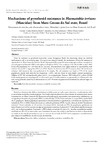Por favor, use este identificador para citar o enlazar este ítem:
http://www.alice.cnptia.embrapa.br/alice/handle/doc/970876Registro completo de metadatos
| Campo DC | Valor | Lengua/Idioma |
|---|---|---|
| dc.contributor.author | BARROS, A. T. M. de | pt_BR |
| dc.contributor.author | SCHUMAKER, T. T. S. | pt_BR |
| dc.contributor.author | KOLLER, W. W. | pt_BR |
| dc.contributor.author | KLAFKE, G. M. | pt_BR |
| dc.contributor.author | ALBUQUERQUE, T. A. de | pt_BR |
| dc.contributor.author | GONZALEZ, R. | pt_BR |
| dc.date.accessioned | 2013-11-08T11:11:11Z | pt_BR |
| dc.date.available | 2013-11-08T11:11:11Z | pt_BR |
| dc.date.created | 2013-11-08 | pt_BR |
| dc.date.issued | 2013 | pt_BR |
| dc.identifier.citation | Revista Brasileira de Parasitologia Veterinária v. 22, n. 1, p. 136-142, 2013. | pt_BR |
| dc.identifier.issn | 0103-846X | pt_BR |
| dc.identifier.uri | http://www.alice.cnptia.embrapa.br/alice/handle/doc/970876 | pt_BR |
| dc.description | Horn fly resistance to pyrethroid insecticides occurs throughout Brazil, but knowledge about the involved mechanisms is still in an incipient stage. This survey was aimed to identify the mechanisms of horn fly resistance to cypermethrin in Mato Grosso do Sul state, Brazil. Impregnated filter paper bioassays using cypermethrin, synergized or not with piperonyl butoxide (PBO) and triphenyl phosphate (TPP), were conducted from March 2004 to June 2005 in horn fly populations (n = 33) from all over the state. All populations were highly resistant to cypermethrin, with resistance factors (RF) ranging from 89.4 to 1,020.6. Polymerase chain reaction (PCR) assays to detect the knockdown resistance (kdr) mutation also were performed in 16 samples. The kdr mutation was found in 75% of the tested populations, mostly with relatively low frequencies (<20%), and was absent in some highly resistant populations. Addition of TPP did not significantly reduce the LC50 in any population. However, PBO reduced LC50s above 40-fold in all tested populations, resulting in RFs ? 10 in most cases. Horn fly resistance to cypermethrin is widespread in the state, being primarily caused by an enhanced activity of P450 mono-oxygenases and secondarily by reduced target site sensitivity. | pt_BR |
| dc.language.iso | por | pt_BR |
| dc.rights | openAccess | pt_BR |
| dc.subject | Horn fly | pt_BR |
| dc.subject | Kdr | pt_BR |
| dc.subject | Metabolic resistance | pt_BR |
| dc.subject | Mosca-dos-chifres | pt_BR |
| dc.subject | Resistência a inseticidas | pt_BR |
| dc.subject | Resistência metabólica | pt_BR |
| dc.title | Mechanisms of pyrethroid resistance in Haematobia irritans (Muscidae) from Mato Grosso do Sul state, Brazil. | pt_BR |
| dc.type | Artigo de periódico | pt_BR |
| dc.date.updated | 2013-11-08T11:11:11Z | pt_BR |
| dc.subject.nalthesaurus | insecticide resistance | pt_BR |
| riaa.ainfo.id | 970876 | pt_BR |
| riaa.ainfo.lastupdate | 2013-11-08 | pt_BR |
| Aparece en las colecciones: | Artigo em periódico indexado (CNPGC)  | |
Ficheros en este ítem:
| Fichero | Descripción | Tamaño | Formato | |
|---|---|---|---|---|
| AntonioThadeuMedeirosBarros0103846Xrbpv0000240.pdf | 323,01 kB | Adobe PDF |  Visualizar/Abrir |









